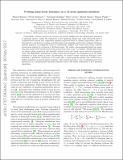Probing many-body dynamics on a 51-atom quantum simulator
Author(s)
Bernien, Hannes; Schwartz, Sylvain; Keesling, Alexander; Levine, Harry; Omran, Ahmed; Pichler, Hannes; Choi, Soonwon; Zibrov, Alexander S; Endres, Manuel; Greiner, Markus; Vuletić, Vladan; Lukin, Mikhail D; ... Show more Show less
DownloadAccepted version (4.113Mb)
Terms of use
Metadata
Show full item recordAbstract
© 2017 Macmillan Publishers Limited, part of Springer Nature. All rights reserved. Controllable, coherent many-body systems can provide insights into the fundamental properties of quantum matter, enable the realization of new quantum phases and could ultimately lead to computational systems that outperform existing computers based on classical approaches. Here we demonstrate a method for creating controlled many-body quantum matter that combines deterministically prepared, reconfigurable arrays of individually trapped cold atoms with strong, coherent interactions enabled by excitation to Rydberg states. We realize a programmable Ising-type quantum spin model with tunable interactions and system sizes of up to 51 qubits. Within this model, we observe phase transitions into spatially ordered states that break various discrete symmetries, verify the high-fidelity preparation of these states and investigate the dynamics across the phase transition in large arrays of atoms. In particular, we observe robust many-body dynamics corresponding to persistent oscillations of the order after a rapid quantum quench that results from a sudden transition across the phase boundary. Our method provides a way of exploring many-body phenomena on a programmable quantum simulator and could enable realizations of new quantum algorithms.
Date issued
2017Department
Massachusetts Institute of Technology. Department of Physics; Massachusetts Institute of Technology. Research Laboratory of ElectronicsJournal
Nature
Publisher
Springer Science and Business Media LLC